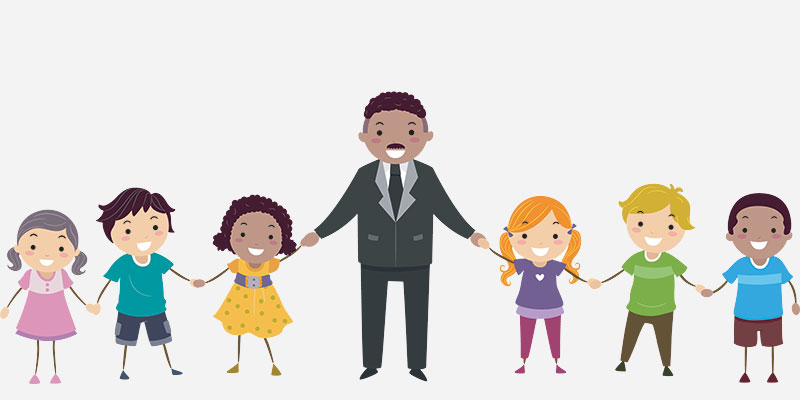Dr. Martin Luther King, Jr., one of the most recognized names in civil rights, social activism, and nonviolent resistance, has been quoted saying,
“In the end, we will remember not the words of our enemies, but the silence of our friends.”
To commemorate all he believed in and the lives he touched, we’re taking a deeper look at this quote and how it can be applied to bullying situations today.
Bullying in schools is far from a thing of the past. While in recent years there has been much conversation about addressing and preventing bullying, StopBullying.Gov reports that 70.6% of students still report seeing bullying at their school. Students who have been bullied most often reported reasons including physical appearance, race/ethnicity, gender, disability, religion, and sexual orientation (National Center for Educational Statistics, 2016).
As reported by StopBullying.Gov, there are four main roles that students play in the dynamics of bullying:
- Kids who bully: These children engage in bullying behavior towards their peers.
- Kids who are bullied: These children are the targets of bullying behavior.
- Bystanders: These children remain separate from the bullying situation. They neither reinforce the bullying behavior nor defend the child being bullied. Some may watch what is going on but do not provide feedback about the situation to show they are on anyone’s side.
*These kids often want to help, but don’t know how. - Kids who defend: These children actively comfort the child being bullied and may come to the child’s defense when bullying occurs.
It is important that we empower children to go from Bystander to Defender. Not only because it is the right thing to do, but because research has proven peer intervention to be highly effective in curbing bullying and minimizing its effects.
A study completed by Hawkins, Pepler, and Craig entitled Naturalistic Observations of Peer Interventions in Bullying, concluded that 57% of bullying episodes stop within 10 seconds when a peer intervenes on behalf of the student being bullied. That’s more than half! Yet, that same study showed that only 19% of the peers observed intervened in bullying situations.
So, why aren’t more kids stepping in? According to Eyes on Bullying, it could be because the bystander thinks it’s “none of their business,” they fear getting hurt, they feel powerless against the aggressor, they think it’ll make things worse, or they just don’t know what to do.
This is why it’s important to give our kids the tools they need to help others. Let’s look at another quote from MLK Jr, “courage is the power of the mind to overcome fear.” These kids may not be the ones being bullied, but they are also afraid! They are filled with confusion and conflicted feelings. Most likely, they want to step in and help, but the fear of retaliation overpowers that desire to speak up.
We have to give kids the courage and confidence they need to stand up for others. Another study done by Thornberg, et al, says “bystanders’ beliefs in their social self-efficacy were positively associated with defending behavior and negatively associated with passive behavior from bystanders – i.e. if students believe they can make a difference, they’re more likely to act.”
What can a bystander do that will help the individual being bullied?
The Youth Voice Research Project (2010) found that victimized students reported the following bystander strategies that made things better:
- Spent time with me (54%)
- Talked to me (51%)
- Helped me get away (49%)
- Called me (47%)
- Gave me advice (46%)
- Helped me tell an adult (44%)
It is notable that the peer actions reported as most helpful are also the safest for peers as well, and represent acts of alliance rather than of confrontation. Even the relatively silent and thus totally safe action of calling a student at home to give support was reported to be helpful much more often than it was unhelpful.
What can we do to teach our kids to be defenders?
-
- Encourage them to befriend the person being bullied. As we have seen in the data listed above, spending time with the other student or talking to them were the two most effective strategies reported.
- Give them different scenarios in which they can help the victim get away. This can be something simple, such as asking the victim to come look at something, or come play with them.
- Equip them with good advice to give the victim. Recent studies have proven that the strategies we have been giving kids to stand up for themselves is only making the situation worse, in most cases. Telling the person to stop, walking away, doing nothing and telling the bully how they felt were reported most likely to make things worse by The Youth Voice Research Project.
Preferred advice to equip our kids with, according to the Youth Voice Research Project, would be to tell an adult (either at home or school), make a joke about it, or tell a friend. These gestures have been proven to be more effective in making the situation better.
- Talk about it! Parents, sit down and have a conversation with your kids about bullying. Don’t assume that your child knows what to do in these situations. Make sure that they get praised when they help others who are being bullied. Let them know how proud you are of them. Teachers, let your classroom know the effectiveness of peer intervention. All kids should be confident knowing that they won’t get in trouble for “tattling.” Positive reinforcement goes a long way!
“Parents, school staff, and other adults in the community can help kids prevent bullying by talking about it, building a safe school environment, and creating a community-wide bullying prevention strategy.” -StopBullying.Gov
Tip for educators: Spark the conversation about bullying in your classroom with our Evo The Troll lesson! This cute lesson combines trolls we know and love from fairytales with tips for dealing with Internet Trolls.









